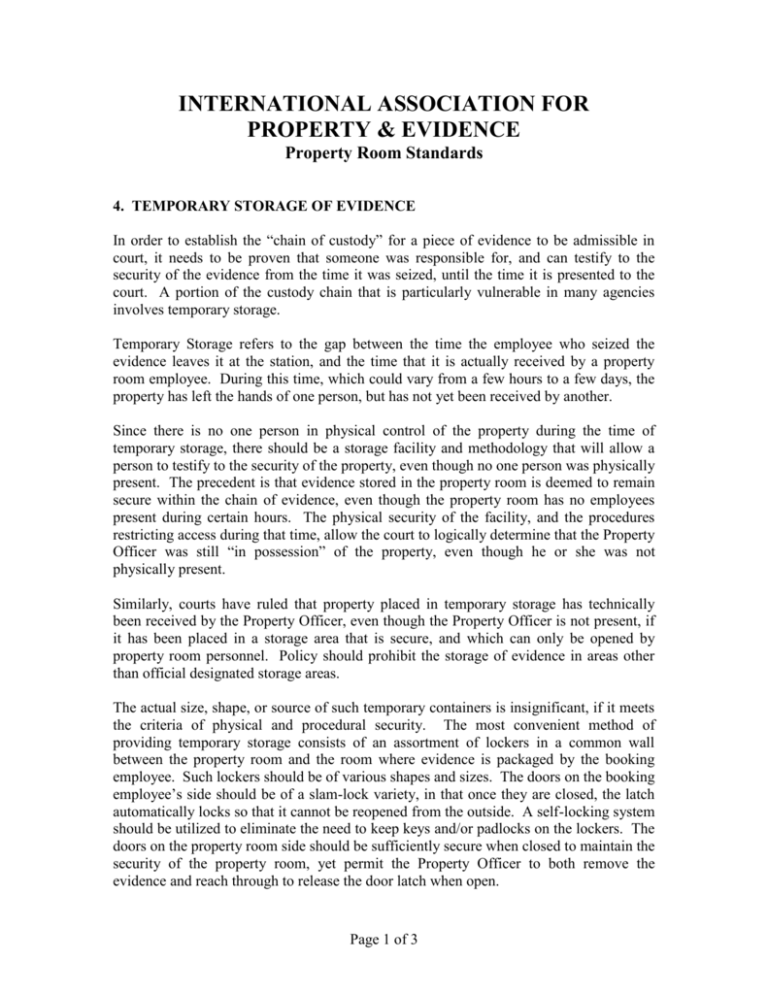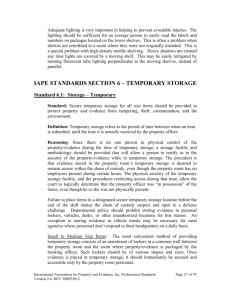IAPE_Standards_2002_04 - International Association For
advertisement

INTERNATIONAL ASSOCIATION FOR PROPERTY & EVIDENCE Property Room Standards 4. TEMPORARY STORAGE OF EVIDENCE In order to establish the “chain of custody” for a piece of evidence to be admissible in court, it needs to be proven that someone was responsible for, and can testify to the security of the evidence from the time it was seized, until the time it is presented to the court. A portion of the custody chain that is particularly vulnerable in many agencies involves temporary storage. Temporary Storage refers to the gap between the time the employee who seized the evidence leaves it at the station, and the time that it is actually received by a property room employee. During this time, which could vary from a few hours to a few days, the property has left the hands of one person, but has not yet been received by another. Since there is no one person in physical control of the property during the time of temporary storage, there should be a storage facility and methodology that will allow a person to testify to the security of the property, even though no one person was physically present. The precedent is that evidence stored in the property room is deemed to remain secure within the chain of evidence, even though the property room has no employees present during certain hours. The physical security of the facility, and the procedures restricting access during that time, allow the court to logically determine that the Property Officer was still “in possession” of the property, even though he or she was not physically present. Similarly, courts have ruled that property placed in temporary storage has technically been received by the Property Officer, even though the Property Officer is not present, if it has been placed in a storage area that is secure, and which can only be opened by property room personnel. Policy should prohibit the storage of evidence in areas other than official designated storage areas. The actual size, shape, or source of such temporary containers is insignificant, if it meets the criteria of physical and procedural security. The most convenient method of providing temporary storage consists of an assortment of lockers in a common wall between the property room and the room where evidence is packaged by the booking employee. Such lockers should be of various shapes and sizes. The doors on the booking employee’s side should be of a slam-lock variety, in that once they are closed, the latch automatically locks so that it cannot be reopened from the outside. A self-locking system should be utilized to eliminate the need to keep keys and/or padlocks on the lockers. The doors on the property room side should be sufficiently secure when closed to maintain the security of the property room, yet permit the Property Officer to both remove the evidence and reach through to release the door latch when open. Page 1 of 3 If lockers with individual keys must be used for temporary storage, the keys should be deposited in an area that only property room personnel have access. Once evidence is placed in temporary storage, it should immediately be secure and accessible from that point only by property room personnel. An area designated for the temporary storage of oversize items is recommended so that such items are not commingled with other evidence items and are safeguarded from potential tampering. Secure temporary storage of biohazard items is recommended. Some items require cold storage if still in a liquid state, or frozen storage if the body fluids have dried. In many instances, bloody items may be stored at controlled room temperature if it has been appropriately dried, depending upon the requirements of the local crime lab. Sexual assault evidence should also be refrigerated/frozen in accordance with local crime lab recommendations. Other biohazards that do not require refrigeration should be placed in a location that is secure, but can easily be decontaminated after each use. A designated drying locker is recommended in order to dry body fluids. A specific location for blood and urine samples that do not require refrigeration is recommended. This location should be easily decontaminated and made of a non-porous material. A temporary storage location for small quantities of hazardous materials, such as chlorine, acid, lye, etc should be provided for. This location should be open to the outside where any escaping fumes will not enter the building’s Heating/Ventilating/Air Conditioning (HVAC) system. All hazardous materials should always be stored in an airtight container. The use of an “explosion proof” cabinet is highly recommended. Large quantities of such hazardous materials should be not be stored in the property section. Consider saving a sample of the larger quantity for scientific analysis and obtaining a court order to dispose of the remainder in major cases. A temporary storage location for small quantities of flammables such as gasoline, kerosene, benzene, etc, pyrotechnics, and commercial ammunition should be provided for. This location should be open to the atmosphere where any escaping fumes will not enter the building’s HVAC system. All hazardous materials should always be stored in an airtight container. The use of an “explosion proof” cabinet is highly recommended. Larger quantities of such hazardous materials should be not be stored in the property room, regardless of the container. Consider saving a small sample of the larger quantity for scientific analysis and obtaining a court order to dispose of the remainder in major cases. As a general rule, perishables should not be stored in the Property Room however, there are circumstances that may require such storage. For this instance, a dedicated refrigerator and a freezer should be made available for temporary storage. Ideally, such a refrigerator would have individual locking compartments to prevent the commingling of Page 2 of 3 evidence. Some departments with a low volume of evidence may opt to merely place a hasp and lock onto a small under-counter refrigerator. Larger departments may choose to place a full-size refrigerator/freezer combination in the temporary storage area. Fingerprints and photos are among the best evidence available to connect a suspect to a crime scene. A drop-slot in a temporary locker is one of the most effective methods of securing latent print cards and exposed, undeveloped film. Audio and video tapes can also be handled in a similar fashion. Consider designating one temporary locker as a “trouble locker” or a “will call locker" to hold improperly documented or packaged items until the submitting officer can make corrections, or for check out by officers during non-business hours. Page 3 of 3











